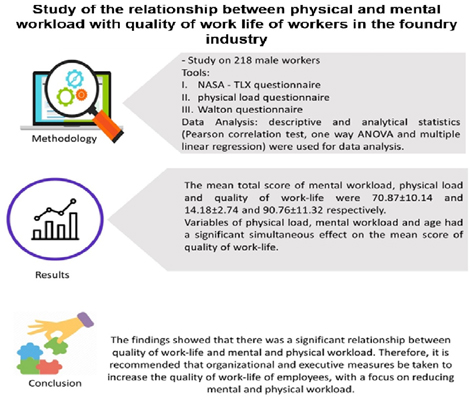Volume 11, Issue 3 (9-2021)
J Health Saf Work 2021, 11(3): 488-502 |
Back to browse issues page
Download citation:
BibTeX | RIS | EndNote | Medlars | ProCite | Reference Manager | RefWorks
Send citation to:



BibTeX | RIS | EndNote | Medlars | ProCite | Reference Manager | RefWorks
Send citation to:
Koozekonan A G, Ahmadi Moshiran V, Sadeghi Yarandi M, Golmohammapour H, Sarbaz B, Zakerian S A. Study of the relationship between physical and mental workload with quality of work life of workers in the foundry industry. J Health Saf Work 2021; 11 (3) :488-502
URL: http://jhsw.tums.ac.ir/article-1-6541-en.html
URL: http://jhsw.tums.ac.ir/article-1-6541-en.html
Aysa Ghasemi Koozekonan1 
 , Vahid Ahmadi Moshiran2
, Vahid Ahmadi Moshiran2 
 , Mohsen Sadeghi Yarandi3
, Mohsen Sadeghi Yarandi3 
 , Hamedeh Golmohammapour3
, Hamedeh Golmohammapour3 
 , Babak Sarbaz3
, Babak Sarbaz3 
 , Seyed Abolfazl Zakerian *
, Seyed Abolfazl Zakerian * 
 4
4

 , Vahid Ahmadi Moshiran2
, Vahid Ahmadi Moshiran2 
 , Mohsen Sadeghi Yarandi3
, Mohsen Sadeghi Yarandi3 
 , Hamedeh Golmohammapour3
, Hamedeh Golmohammapour3 
 , Babak Sarbaz3
, Babak Sarbaz3 
 , Seyed Abolfazl Zakerian *
, Seyed Abolfazl Zakerian * 
 4
4
1- Department of Occupational Health Engineering, School of Public Health and Safety, Shahid Beheshti University of Medical Sciences, Tehran, Iran
2- Department of Occupational Health Engineering, School of Public Health, Hamadan University of Medical Sciences, Hamadan, Iran
3- Department of Occupational Health Engineering, School of health, Tehran University of medical sciences, Tehran, Iran
4- Department of Occupational Health Engineering, School of health, Tehran University of medical sciences, Tehran, Iran ,zakerian@tums.ac.ir
2- Department of Occupational Health Engineering, School of Public Health, Hamadan University of Medical Sciences, Hamadan, Iran
3- Department of Occupational Health Engineering, School of health, Tehran University of medical sciences, Tehran, Iran
4- Department of Occupational Health Engineering, School of health, Tehran University of medical sciences, Tehran, Iran ,
Abstract: (2391 Views)
Introduction: One of the most important factors affecting quality of work-life (QWL) is the workload in the form of mental and physical. The increased workload may reduce the level of performance of workers. Therefore, the present study aimed to evaluate the relation of the mental and physicalworkload with the QWLof workers in the foundry industry.
Material and Methods: This cross-sectional study was conducted on 218 male workers in a foundry industry and the work units with high work stress were selected. The NASA-TLX, physical load and the Walton questionnaires were used to collect and evaluate the workload and the QWL.The SPSS software was used for data analysis.
Results: It was clarified that there was a significant inverse relationship between QWL with physical load (P = 0.001) and mental workload (P = 0.01). The comparison of mean QWL between different groups of demographic variables showed that the only significant relationship was between different age groups and QWL (P = 0.003). Finally, it was found that the variables of physical load, mental workload and age had a significant simultaneous effect on the mean score of QWL (P<0.05).
Conclusion: The findings showed that there was a significant relationship between QWL and mental and physical workloads.
Material and Methods: This cross-sectional study was conducted on 218 male workers in a foundry industry and the work units with high work stress were selected. The NASA-TLX, physical load and the Walton questionnaires were used to collect and evaluate the workload and the QWL.The SPSS software was used for data analysis.
Results: It was clarified that there was a significant inverse relationship between QWL with physical load (P = 0.001) and mental workload (P = 0.01). The comparison of mean QWL between different groups of demographic variables showed that the only significant relationship was between different age groups and QWL (P = 0.003). Finally, it was found that the variables of physical load, mental workload and age had a significant simultaneous effect on the mean score of QWL (P<0.05).
Conclusion: The findings showed that there was a significant relationship between QWL and mental and physical workloads.
Type of Study: Research |
Received: 2021/09/20 | Accepted: 2021/09/1 | Published: 2021/09/1
Received: 2021/09/20 | Accepted: 2021/09/1 | Published: 2021/09/1
Send email to the article author
| Rights and permissions | |
 |
This work is licensed under a Creative Commons Attribution-NonCommercial 4.0 International License. |




